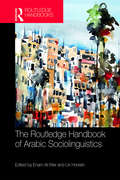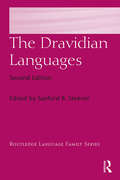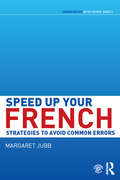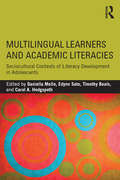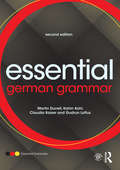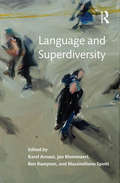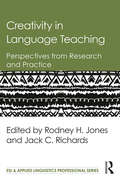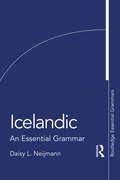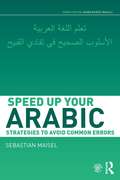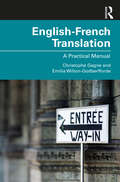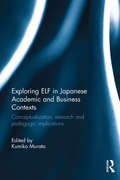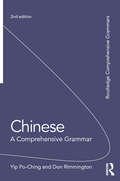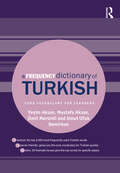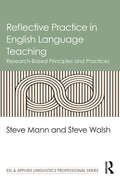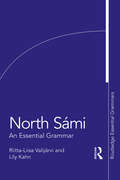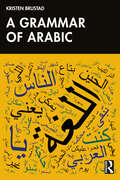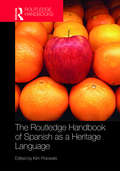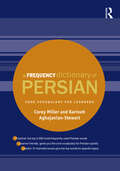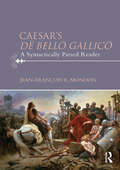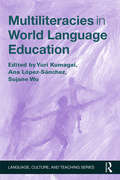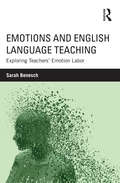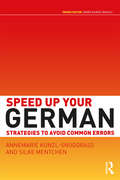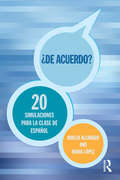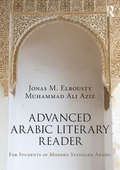- Table View
- List View
The Routledge Handbook of Arabic Sociolinguistics
by Enam Al-Wer Uri HoreshThe Routledge Handbook of Arabic Sociolinguistics comprises 22 chapters encompassing various aspects in the study of Arabic dialects within their sociolinguistic context. This is a novel volume, which not only includes the traditional topics in variationist sociolinguistics, but also links the sociolinguistic enterprise to the history of Arabic and to applications of sociolinguistics beyond the theoretical treatment of variation. Newly formed trends, with an eye to future research, form the backbone of this volume. With contributions from an international pool of researchers, this volume will be of interest to scholars and students of Arabic sociolinguistics, as well as to linguists interested in a concise, rounded view of the field.
The Dravidian Languages (Routledge Language Family Series)
by Sanford SteeverThe Dravidian language family is the world's fourth largest with nearly 250 million speakers across South Asia from Pakistan to Nepal, from Bangladesh to Sri Lanka. This authoritative reference source provides a unique description of the languages, covering their grammatical structure and historical development, plus sociolinguistic features. Each chapter combines modern linguistic perspective with traditional historical linguistics, and a uniform structure allows for easy typological comparison between the individual languages. New to this edition are chapters on Beṭṭa Kuṟumba, Kuṛux, Kūvi and Malayāḷam, enlarged sections in various existing chapters, as well updated bibliographies and demographic data throughout. The Dravidian Languages will be invaluable to students and researchers within linguistics, and will also be of interest to readers in the fields of comparative literature, areal linguistics and South Asian studies.
The Dravidian Languages (Routledge Language Family Series)
by Sanford B. SteeverThe Dravidian language family is the world's fourth largest with nearly 250 million speakers across South Asia from Pakistan to Nepal, from Bangladesh to Sri Lanka. This authoritative reference source provides a unique description of the languages, covering their grammatical structure and historical development, plus sociolinguistic features. Each chapter combines a modern linguistic perspective with traditional historical linguistics, and a uniform structure allows for easy typological comparison between the individual languages. New to this edition are chapters on Beṭṭa Kuṟumba, Kuṛux, Kūvi and Malayāḷam, and enlarged sections in various existing chapters, as well as updated bibliographies and demographic data throughout.The Dravidian Languages will be invaluable to students and researchers within linguistics, and will also be of interest to readers in the fields of comparative literature, areal linguistics and South Asian studies.
Speed up your French: Strategies to Avoid Common Errors (Speed Up Your Language Skills Ser.)
by Margaret JubbSpeed up your French is a unique and innovative resource that identifies and explains the errors most commonly made by students of French. From false friends to idiomatic expressions and the use of prepositions, each of the nine chapters focuses on an aspect of the language where English speakers typically make mistakes. Full explanations are provided throughout with clear, comprehensive examples, enabling students to acquire a surer grasp of French vocabulary and idiom, as well as grammar. Key Features: carefully selected grammar topics and examples based on the most commonly made errors extensive exercises and answer key to reinforce learning, link theory to practice and promote self-study use of mnemonic devices, including visual illustrations, to aid understanding Supplementary exercises and answer key available at www.routledge.com/cw/Jubb Suitable both for classroom use or self-study, Speed up your French is the ideal resource for all intermediate learners of French wishing to refine their language skills.
Multilingual Learners and Academic Literacies: Sociocultural Contexts of Literacy Development in Adolescents
by Daniella Molle Edynn Sato Timothy Boals Carol A. HedgspethShifting the discourse from a focus on academic language to the more dynamic but less researched construct of academic literacies, this volume addresses three key questions: • What constitutes academic literacy? • What does academic literacy development in adolescent multilingual students look like and how can this development be assessed? • What classroom contexts foster the development of academic literacies in multilingual adolescents? The contributing authors provide divergent definitions of academic literacies and use dissimilar theoretical and methodological approaches to study literacy development. Nevertheless, all chapters reflect a shared conceptual framework for examining academic literacies as situated, overlapping, meaning-making practices. This framework foregrounds students’ participation in valued disciplinary literacy practices. Emphasized in the new college and career readiness standards, the notion of disciplinary practices allows the contributing authors to bridge the language/content dichotomy, and take a more holistic as well as nuanced view of the demands that multilingual students face in general education classrooms. The volume also explores the implications of the emphasis on academic literacy practices for classroom instruction, research, and policy.
Essential German Grammar (Essential Language Grammars)
by Martin Durrell Katrin Kohl Gudrun Loftus Claudia KaiserEssential German Grammar is a student-friendly grammar and workbook designed to give learners a firm foundation on which to build a real understanding of both spoken and written German. The reference grammar section offers clear explanations of key grammar points while a separate exercise section gives students the opportunity to test themselves and put into practice what they have learned. This new edition has been revised and updated throughout. Explanations, tables and exercises have been improved and a number of the authentic texts and illustrations have been replaced by new material. Key features of this second edition include: User-friendly layout with updated 2 colour design, engaging illustrations and visually appealing tables throughout to aid the learning process Clear and accessible explanations with memorable examples informed by the latest research on the German language and presented in accordance with current teaching methodology Helpful parallels between English and German provided where relevant End-of-chapter extracts taken from contemporary journalistic or authentic literary sources, illustrating grammar in context, with model translations provided at the back of the book Material to enable better strategic learning and understanding, including a Why Grammar?—FAQ section, a glossary of grammatical terms in both English and German and a complete answer key to exercises Created especially for the new edition, a companion website at www.routledge.com/cw/kaiser offering a wealth of additional materials, including interactive exercises, quizzes and flashcards to test student understanding, downloadable PDF sheets for classroom use, PowerPoint slides for instructors and audio recordings illustrating the sounds of spoken German. Written by highly experienced lecturers in the field, Essential German Grammar is an invaluable resource for intermediate and advanced students of German (CEFR levels A2 to B2, ACTFL Novice High to Intermediate High). It is designed to function equally as a free-standing grammar or as a foundation grammar for Hammer’s German Grammar and Usage and is suitable for both classroom use and self-study.
Language and Superdiversity: Recombining Spaces, Times And Language Practices (Encounters Ser. #7)
by Jan Blommaert Karel Arnaut Massimiliano Spotti Ben RamptonA first synthesis of work done in sociolinguistic superdiversity, this volume offers a substantial introduction to the field and the issues and state-of-the-art research papers organized around three themes: Sketching the paradigm, Sociolinguistic complexity, Policing complexity. The focus is to show how complexity rather than plurality can serve as a lens through which an equally vast range of topics, sites, and issues can be tied together. Superdiversity captures the acceleration and intensification of processes of social ‘mixing’ and ‘fragmentation’ since the early 1990s, as an outcome of two different but related processes: new post-Cold War migration flows, and the advent and spread of the Internet and mobile technologies. The confluence of these forces have created entirely new sociolinguistic environments, leading to research in the past decade that has brought a mixture of new empirical terrain–extreme diversity in language and literacy resources, complex repertoires and practices of participants in interaction–and conceptual challenges. Language and Superdiversity is a landmark volume bringing together the work of the scholars and researchers who spearhead the development of the sociolinguistics of superdiversity.
Creativity in Language Teaching: Perspectives from Research and Practice (ESL & Applied Linguistics Professional Series)
by Jack C. Richards Rodney H. JonesCurrent, comprehensive, and authoritative, this text gives language teachers and researchers, both a set of conceptual tools with which to think and talk about creativity in language teaching and a wealth of practical advice about principles and practices that can be applied to making their lessons more creative. Providing an overview of the nature of creativity and its role in second language education, it brings together twenty prominent language teachers and researchers with expertise in different aspects of creativity and teaching contexts to present a range of theories on both creative processes and how these processes lead to creative practices in language teaching. Unique in the field, the book takes a broader and more critical look at the notion of creativity in language learning, exploring its linguistic, cognitive, sociocultural and pedagogic dimensions. Structured in four sections— theoretical perspectives, creativity in the classroom, creativity in the curriculum, and creativity in teacher development—each chapter is supplemented by Questions for Discussion and Suggestions for Further Research. Its accessible style makes the book relevant as both a course text and a resource for practicing teachers.
Icelandic: An Essential Grammar (Routledge Essential Grammars #1)
by Daisy L. NeijmannIcelandic: An Essential Grammar is a concise and convenient guide to the basic grammatical structure of Icelandic. Presenting a fresh and accessible description of the language, this engaging Grammar uses clear, jargon-free explanations and sets out the complexities of Icelandic in short, readable sections. Each grammar point is illustrated with numerous examples drawn from everyday life, clarifying the grammatical structure in use while providing insight into Icelandic culture. Icelandic: An Essential Grammar is the ideal reference grammar for all learners of Icelandic, whether class-based or independent, looking to progress beyond beginner level.
Speed up your Arabic: Strategies to Avoid Common Errors
by Sebastian MaiselPronunciation, spelling, the concept of roots and patterns and idomatic phrases are just some of the areas that cause confusion for students of Arabic. Learning how to avoid the common errors that arise repeatedly in these areas is an essential step in successful language learning. Speed Up Your Arabic is a unique and innovative resource that identifies and explains the most commonly made errors, enabling students to learn from their mistakes and enhance their understanding of the Arabic language. Each of the nine chapters focuses on a grammatical category where English speakers typically make mistakes in Arabic. Each chapter is divided into sections that classify the concepts and errors into subcategories. Full explanations are provided throughout with clear, comprehensive examples and exercises to help the learner gain an in-depth understanding of Arabic grammar and usage. Key features: Carefully selected grammar topics and examples based on the most commonly made errors Comprehensive explanations of the most difficult grammar points help learners gain an in-depth understanding of Arabic grammar and usage. Exercises throughout reinforce learning and link theory to practice A complete answer key making it ideal for self-study A glossary of grammatical terms, an Arabic-English glossary and a bibliography to aid learning Useful drills and listening samples available for free download at http://www.routledge.com/books/details/9780415660556/ Suitable both for classroom use or self-study, Speed Up Your Arabic is the ideal resource for all intermediate learners of Arabic wishing to refine their language skills.
English-French Translation: A Practical Manual
by Emilia Wilton-Godberfforde Christophe GagneEnglish-French Translation: A Practical Manual allows advanced learners of French to develop their translation and writing skills. This book provides a deeper understanding of French grammatical structures, the nuances of different styles and registers and helps increase knowledge of vocabulary and idiomatic language. The manual provides a wealth of practical tasks based around carefully selected extracts from the diverse text types students are likely to encounter, from literary and expository, to persuasive and journalistic. A mix of shorter targeted activities and lengthier translation pieces guides learners through the complexities and challenges of translation from English into French. This comprehensive manual is ideal for advanced undergraduate and postgraduate students in French language and translation.
Exploring ELF in Japanese Academic and Business Contexts: Conceptualisation, research and pedagogic implications
by Kumiko MurataThis book investigates the theoretical, empirical and pedagogical issues to help us better understand what is happening with English as a Lingua Franca (ELF) communication and to activate this knowledge in respective communicative contexts. It focuses specifically on Japanese contexts and also includes theoretical and practical sections pertinent to all ELF researchers, practitioners and students, irrespective of their national or regional differences. It further attempts to connect this new field of research to established fields of linguistics and applied linguistics such as communication, assessment and multilingualism by exploring them from an ELF perspective, which is challenging but essential for the development of the field. Exploring ELF in Japanese Academic and Business Contexts: Conceptualisation, research and pedagogic implications includes chapters about: English in a Global Context Own-language use in academic discourse English as a lingua franca in international business contexts A linguistic soundscape/landscape analysis of ELF information provision in public transport in Tokyo Using pragmatic strategies for effective ELF communication: Relevance to classroom practice This book will be of interest to scholars and post-graduate students working in the fields of Applied Linguistics/TESOL. It will also engage researchers studying the growing influence of English around the world.
Chinese: A Comprehensive Grammar
by Yip Po-Ching Don RimmingtonChinese: A Comprehensive Grammar is a complete reference guide to Chinese grammar which presents a fresh and accessible description of the language, concentrating on the real patterns of use in modern Chinese. The volume is organized to promote a thorough understanding of Chinese grammar. It offers a stimulating analysis of the complexities of the language and provides full and clear explanations. Throughout, the emphasis is on Chinese as used by present-day native speakers. An extensive index and numbered paragraphs provide readers with easy access to the information they require. The new edition features a revised and expanded chapter on prosody (Prosody and Syntax), as well as four completely new chapters: • Morphology and Syntax (I) looks at Chinese word formation • Morphology and Syntax (II) explores the interaction between words, expressions and sentences • Intralingual Transpositions reviews the possible conversions between sentential constructions • Interlingual Conversions examines the differences between Chinese and English. The Grammar is an essential reference source for the adult learner and user of Chinese. It is ideal for independent study and for use in schools, colleges, universities and adult classes, up to an advanced level.
A Frequency Dictionary of Turkish: Core Vocabulary For Learners (Routledge Frequency Dictionaries)
by Yeşim Aksan Mustafa Aksan Ümit Mersinli Umut DemirhanA Frequency Dictionary of Turkish enables students of all levels to build on their study of Turkish in an efficient and engaging way. <P><P> Based on a 50 million word corpus, A Frequency Dictionary of Turkish provides a list of core vocabulary for learners of Turkish as a second or foreign language. It gives the most updated, reliable frequency guidelines for common vocabulary in spoken and written Turkish. Each of the 5000 entries are supported by detailed information including the English equivalent, an illustrative example with English translation and usage statistics. The Dictionary provides a rich resource for language teaching and curriculum design, while a separate CD version provides the full text in a tab-delimited format ideally suited for use by corpus and computational linguists. With entries arranged by frequency, by suffixation and alphabetically, A Frequency Dictionary of Turkish enables students of all levels to get the most out of their study of vocabulary in an engaging and efficient way.
Reflective Practice in English Language Teaching: Research-Based Principles and Practices (ESL & Applied Linguistics Professional Series)
by Steve Mann Steve WalshOffering a unique, data-led, evidence-based approach to reflective practice in English language teaching, this book brings together theory, research and practice in an accessible way to demonstrate what reflective practice looks like and how it is undertaken in a range of contexts. Readers learn how to do and to research reflective practice in their own settings. Through the use of data, dialogue and appropriate tools, the authors show how reflective practice can be used as an ongoing teaching tool that supports professional self-development.
North Sámi: An Essential Grammar (Routledge Essential Grammars)
by Lily Kahn Riitta-Liisa ValijärviNorth Sámi: An Essential Grammar is the most up-to-date work on North Sámi grammar to be published in English. The book provides: a clear and comprehensive overview of modern Sámi grammar including examples drawn from authentic texts of various genres. a systematic order of topics beginning with the alphabet and phonology, continuing with nominal and verbal morphology and syntax, and concluding with more advanced topics such as discourse particles, complex sentences, and word formation. full explanations of the grammatical terminology for the benefit of readers without a background in linguistics. ? Suitable for linguists, as well as independent and classroom-based students, North Sámi: An Essential Grammar is an accessible but thorough introduction to the essential morphology and syntax of modern North Sámi, the largest of the Sámi languages.
A Grammar of Arabic
by Kristen BrustadA Grammar of Arabic models a new framework for studying varieties of Arabic comparatively, highlighting the patterns of variation and consistency, and showing how different styles, from primarily spoken and casual to primarily written and formal, are linguistically interrelated.This non-traditional reference grammar is structured around patterns of usage rather than prescriptive rules, aligning function with form and taking advantage of general principles of language. Using data from Classical Arabic, Arabic, Modern Standard Arabic, and dialects spoken in Morocco, Egypt, Sudan, the Levant, Iraq, and the Arabian Gulf, this grammar examines the actual usage of these language varieties, broadening understanding of Arabic dialects from a linguistics perspective while also giving readers the ability to engage language diversity.Designed for instructors, researchers, and advanced students of Arabic, A Grammar of Arabic explores Arabic from an internally comparative perspective that will also be valuable to theoretical linguists.
The Routledge Handbook of Spanish as a Heritage Language (Routledge Spanish Language Handbooks)
by Kim PotowskiThe Routledge Handbook of Spanish as a Heritage Language brings together contributions from leading linguists, educators and Latino Studies scholars involved in teaching and working with Spanish heritage language speakers. This state-of-the-art overview covers a range of topics within five broad areas: Spanish in U.S. public life, Spanish heritage language use and systems, educational contexts, Latino studies perspectives and Spanish outside the U.S. The Routledge Handbook of Spanish as a Heritage Language addresses for the first time the linguistic, educational and social aspects of heritage Spanish speakers in one volume making it an indispensable reference for anyone working with Spanish as a heritage language.
A Frequency Dictionary of Persian: Core vocabulary for learners (Routledge Frequency Dictionaries)
by Corey Miller Karineh Aghajanian-StewartA Frequency Dictionary of Persian is an invaluable tool for all learners of Persian, providing a list of the 5,000 most frequently used words in the language. Based on a 150 million word corpus of written and spoken Persian texts from the Iranian world, the Dictionary provides the user with a detailed frequency-based list, plus alphabetical and part-of-speech indices. All entries feature the English equivalent, and an example of use in context. The Dictionary also features thematically-based lists of frequently used words on a variety of topics. Also featured are some grammatically-oriented lists, such as simple verbs and light verb constructions, and comparisons of different ways of expressing the months of the year. The Dictionary provides a rich resource for language teaching and curriculum design, while a separate CD version provides the full text in a tab-delimited format ideally suited for use by corpus and computational linguists. A Frequency Dictionary of Persian enables students of all levels to build on their study of Persian in an efficient and engaging way.
Caesar’s Dē Bellō Gallicō: A Syntactically Parsed Reader
by Jean-François R. Mondon<p>Caesar’s Dē Bellō Gallicō: A Syntactically Parsed Reader is an innovative Latin reader presenting selections of Caesar’s Gallic wars texts. Its unique approach tackles the two most common problems a student reading unedited Latin faces: abundant vocabulary and a maze-like sentence structure. Breaking down the sentence structure of the texts and providing vocabulary glosses throughout, A Syntactically Parsed Reader ensures better comprehension and enables students to make an easier transition from using artificial and doctored Latin to working with the unaltered language found in authentic texts. <p>Features include: <p> <li>Texts presented with the syntactically parsed Latin on one page and vocabulary glosses on the other <li>Visual display of the syntactic structure of each Latin sentence throughout, with main clauses touching the left margin, subordinate clauses shown indented, and multiple subordinate clauses arranged to illustrate which clauses are dependent on which other clauses <li>Helpful grammar notes provided alongside the texts <li>High frequency vocabulary included in a separate appendix to encourage efficient vocabulary acquisition <li>Selected texts carefully chosen in line with the Advanced Placement Latin exam. </li> <p> <p>Caesar’s Dē Bellō Gallicō: A Syntactically Parsed Reader has been developed by an experienced university instructor. It is ideal for students seeking to improve their ability to read and understand Latin prose straight from the page.</p>
Multiliteracies in World Language Education (Language, Culture, and Teaching Series)
by Yuri Kumagai Ana López-Sánchez Sujane WuPutting a multiliteracies framework at the center of the world language curriculum, this volume brings together college-level curricular innovations and classroom projects that address differences in meaning and worldviews expressed in learners’ primary and target languages. Offering a rich understanding of languages, genres, and modalities as socioculturally situated semiotic systems, it advocates an effective pedagogy for developing learners’ abilities to operate between languages. Chapters showcase curricula that draw on a multiliteracies framework and present various classroom projects that develop aspects of multiliteracies for language learners. A discussion of the theoretical background and historical development of the pedagogy of multiliteracies and its relevance to the field of world language education positions this book within the broader literature on foreign language education. As developments in globalization, accountability, and austerity challenge contemporary academia and the current structure of world language programs, this book shows how the implementation of a multiliteracies-based approach brings coherence to language programs, and how the framework can help to accomplish the goals of higher education in general and of language education in particular.
Emotions and English Language Teaching: Exploring Teachers’ Emotion Labor
by Sarah BeneschTaking a critical approach that considers the role of power, and resistance to power, in teachers’ affective lives, Sarah Benesch examines the relationship between English language teaching and emotions in postsecondary classrooms. The exploration takes into account implicit feeling rules that may drive institutional expectations of teacher performance and affect teachers’ responses to and decisions about pedagogical matters. Based on interviews with postsecondary English language teachers, the book analyzes ways in which they negotiate tension—theorized as emotion labor—between feeling rules and teachers’ professional training and/or experience, in particularly challenging areas of teaching: high-stakes literacy testing; responding to student writing; plagiarism; and attendance. Discussion of this rich interview data offers an expanded and nuanced understanding of English language teaching, one positing teachers’ emotion labor as a framework for theorizing emotions critically and as a tool of teacher agency and resistance.
Speed up your German: Strategies to Avoid Common Errors
by Silke Mentchen Annemarie Kunzl-SnodgrassSpeed Up Your German is a unique and innovative resource that identifies and explains the errors most commonly made by learners of German, enabling students to learn from their mistakes while enhancing their understanding of the German language. Each of the eighteen chapters focuses on a grammatical category where English speakers typically make mistakes. Each chapter is subdivided into two levels: Level 1 explains the root cause of the error while level 2 goes deeper into the grammar allowing students to choose the level they want to work at. Each point is clearly explained and exemplified and a range of exercises reinforce learning. Suitable both for classroom use or self-study, Speed Up Your German is the ideal resource for all intermediate learners of German wishing to refine their language skills.
¿De acuerdo? 20 simulaciones para la clase de español
by Noelia Alcarazo Lopez López Nuria¿De acuerdo? 20 Simulaciones para la clase de español es el manual perfecto para estudiantes de español de nivel intermedio y avanzado que quieren desarrollar su destreza oral. El libro presenta 20 simulaciones que proporcionan un marco eficaz y motivador para el desarrollo de la destreza oral y la producción del habla espontánea. Los estudiantes asumen un papel que les permite expresar opiniones, discutir y debatir dentro de un contexto significativo, preparándolos para situaciones de la vida real. ¿De acuerdo? 20 Simulaciones para la clase de español is the ideal course for intermediate to advanced students of Spanish seeking to develop their speaking skills. The book presents 20 simulations which provide an effective and motivating framework for developing speaking skills and producing spontaneous speech. Students take on a role allowing them to express opinions, argue and debate within a meaningful context that prepares them for real-life situations.
Advanced Arabic Literary Reader: For Students of Modern Standard Arabic
by Jonas Elbousty Muhammad AzizAdvanced Arabic Literary Reader is a truly representative collection of literary extracts from across the Arabic-speaking world. Extracts from each country in the Arab world have been carefully selected, with a balance of both male and female writers and prominent and emerging voices, providing a unique window into the Arab world. ? Suitable for both class use and independent study, each extract is supported by an introduction to the author, pre-reading activities, comprehension questions and discussion questions. These activities are designed to help learners expand and reinforce their vocabulary, develop their oral and written proficiency and stimulate further exploration of the cultural and historical background of the texts. ? Written entirely in Arabic, the Advanced Arabic Literary Reader is an essential text for advanced students who wish to further their reading, speaking, and writing ability in Modern Standard Arabic. Free audio recordings of the extracts are available online at www.routledge.com/books/details/9781138828698/ to enable students to improve listening skills.
